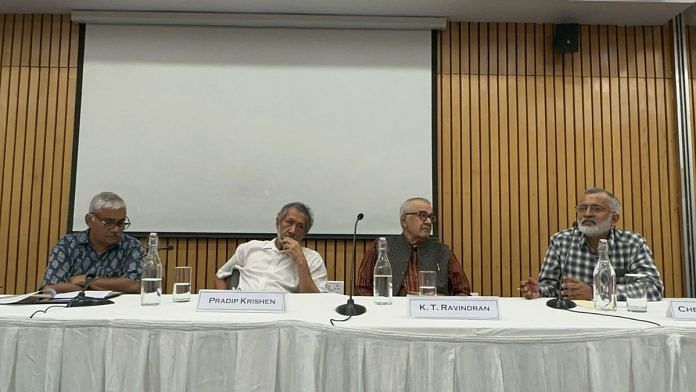New Delhi: Author and environmentalist Pradip Krishen borrowed a word from Salman Rushdie’s Midnight Children to describe the state of the Delhi central ridge forest. The ridge, according to him, has become a very rutputty place—ramshackle or derelict.
“I have been walking through the ridge for the past fifty years and I don’t think anyone can argue that the ridge has become a very rutputty place,” said the ecological restorer and bestselling author of Trees of Delhi.
Daily walks have made Krishen a first-hand observer of the ridge’s quiet resilience as well as its steady decline. In an hour-long lecture, Krishen traced the ridge’s tangled ecological history and urged citizens to play a more active role in its preservation. The lecture was the fifth in a curated series of talks called ‘Living Landscapes’ held at the India International Centre, examining how the relationship between natural and built environment can positively enrich each other. Krishen’s talk highlighted the highly degraded and often overlooked landscape of the Central Ridge, an 850-hectare expanse located right in the middle of one of the largest metropolitan cities in the world.
Often referred to as the ‘green lungs’ of one of the world’s most polluted cities, the ridge is home to boars, jackals, macaques and cows. But what remains ubiquitous are the mounds of garbage everywhere.
‘People think that anything ‘jungle’ is a place to dump things,’ Krishen said.
It isn’t just ordinary citizens. The government played a leading role in the forest’s relegation into a glorified dumping ground. According to Krishen, the President’s bodyguard, the elite cavalry regiment of the Indian Army, regularly uses the ridge as a dumping ground. Some of these spots are even used as burial grounds for the cavalry’s horses.
“I actually had to try to stop a police van from coming and discarding chairs, tables and uniforms in the forest,” he continued, appalled.
Also read: Forests and agriculture can thrive together. 5 Indian states show how
The risks of restoration
As the years passed, the forest’s biodiversity has steadily shrunk. Krishen notes that a tiny herd of Nilgai disappeared only 10 years ago, unviable in small numbers.
“There are no foxes or black-naped hares left on the ridge anymore. Monitor lizards have become rare and elusive. I’ve only seen one rat snake all year,” he continued, his familiarity with the forest leading him to see what others have not yet noticed.
Another problem negatively impacting biodiversity is the ubiquitous presence of the Vilayati kikar (Neltuma Juliflora), which makes up over 90 per cent of the trees on the Central Ridge. This invasive species, native to Central and South America, was planted by colonial officers in the hope of combating desertification, but quietly outcompeted and edged out native trees of the Ridge.
Unsurprisingly, the ridge has also seen rampant land grabs, encroachments, and consistent mismanagement by government agencies.
In June 2021, a botany professor from a major Indian university headed a restoration project for the Central Ridge. Krishen, who was on the advisory board, recalled the professor’s opening remarks.
“He said he was going to restore the central ridge and make it like New York’s Central Park,” Krishen recalled, astonished. Central Park, though beautiful, is hardly a restored natural ecosystem. “He went on to say that there would be handball courts and tennis courts.”
Efforts remain consistent, but are hampered by a poor grasp of ecological restoration. In 2022, Delhi’s Forest Department launched a pilot restoration project on 40 hectares of the Northern Ridge. JCBs cleared all vegetation except trees, which were later heavily pruned. Thousands of uniform pits were dug to plant a limited mix of species, including exotics like Jungle Jalebi and Kigelia africana, which did not belong in the ridge’s ecosystem.
“This is what happens when ecological restoration is outsourced to contractors,” Krishen said.
He proposes that the restoration community reach out to the Forest Department to integrate real restoration methods into their training, such as deliberate selection of native species and aiming for a living, self-organising ecosystem rather than rows of nursery stock. “We mustn’t blame officers for not knowing what they have not been told, and therefore don’t know,” he said.
There is a certain level of cautious optimism in Krishen’s talk.
“It’s remarkable that the Central Ridge still exists at all,” Krishen pointed out. It is largely the result of NGOs like Kalp Vriksh, Shrishti, Toxics Links and environmentalist MC Mehta that the Ridge has survived further degradation.
“We owe them our gratitude and salaams,” Krishen said.
Also read: Delhi Ridge: How it went from a colonial forest to murder scene to morning-walk garden
A collaboration
The talk was followed by a panel discussion with urban designer and architect Professor KT Ravindran and environmentalist Chetan Agarwal. It was moderated by architect, writer and photographer Anuj Srivastava.
The audience, made up largely of passionate young environmental activists alongside veterans from the movements, pressed the panel discussants for answers on what to do next and how to get it done. Patiently, the participants dissected each question, ranging from invasive tree species to the place of urban design in the ridge’s conservation.
During the panel discussion, Krishen interrupted a participant mid-sentence to make a sudden, urgent plea for optimism, “There is one overwhelming reason why there’s hope for the central ridge: it is that the soil is still alive. The soil has not been drenched with toxic chemicals and chemical fertilisers.”
But how would you bring the entire area back to life? Kishen had an answer for that. “It’s going to be a big collaborative thing. It isn’t within the capacity of the forest department. It’s going to need landscape architects, it’s going to need artists, it’s going to need planners, it’s going to need writers. It’s gonna need imagination, you know?”
(Edited by Theres Sudeep)






